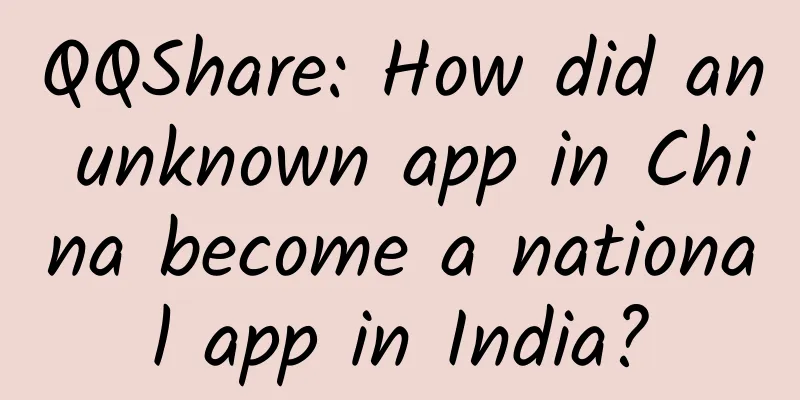QQShare: How did an unknown app in China become a national app in India?

|
In China, not many people know Yan Fei and his Eggplant Quick Transfer. About Yan Fei, most of the information you can search is that he once worked on an APP product called Macu Notes at Shanda Innovation Institute, and later joined Lenovo as product director of the cloud service group. He is now the CEO of Eggplant Quick Transfer. There is more information about 茄子快转. The most famous connection is that it was incubated by Lenovo Group and spun off in 2013. Whenever Yang Yuanqing, chairman and CEO of Lenovo Group, talked about Lenovo's mobile Internet transformation, he almost always mentioned 茄子快转. That's all. But in India, the situation is completely different. In Mumbai, New Delhi, Bangalore, Gurgaon or any other city, if you pick up an Indian with a smartphone, he or she will have "SHAREit" installed on their phone. This is the name of SHAREit in overseas markets. In India, its total number of users exceeds 150 million, transmitting more than 80% of the content on India's smart devices. Along with WhatsApp, Facebook, etc., it has become the "national software" that Indians must choose after purchasing smartphones. How is this done? Yan Fei said, at the beginning, we didn’t know either. 1. Unintentional planting of eggplants and their flowering Like the vast majority of Chinese Internet apps that have gone overseas, Yan Fei did not have high expectations when Eggplant Quick Transfer first entered India in 2014. Firstly, India is just one of many international markets. Secondly, Lenovo, the old company, has dominated the Indian market with its mobile phones. It is a common practice for Eggplant Quick Transfer to take advantage of SF Express and pre-install it on Lenovo phones with a simple push. But the data fed back from official application platforms such as Google Play and App Store shocked Yan Fei. In one year, the number of users of SHAREit has grown exponentially, directly exceeding 100 million, and the number of new users per day is as high as 1.5 million. At that time, 茄子快传 had just been spun off from Lenovo. The entire team had only more than 30 people (now there are only more than 60 people). It did not have any offices in India, did not hire any local Indian employees, and basically did no local promotion. Where did the users come from? The Lenovo mobile phone tailwind certainly played a role, but Lenovo's mobile phone shipments in the Indian market are around 10 million units per year, which is not enough to allow the number of Eggplant Quick Transfer users to increase to this level in such a short period of time. There must be other more important reasons. Yan Fei then sent several groups of employees to India. After several weeks of in-depth investigations into user habits, market environment, and competitive product analysis, he finally found several clues. First, India did not experience the popularization of desktop PC Internet, but directly entered the mobile Internet era. More than 70% of Internet access is done using mobile phones. Second, India's network infrastructure is at a low level and the network environment is poor. About two-thirds of users are still using 2G and narrowband telephone dial-up to access the Internet. Even for some hotels' paid WiFi, the peak speed is only 100Kb/s. Third, the penetration rate of smartphones in India is low but the growth rate is obvious. There are 600 million mobile phone users in India, with a penetration rate of over 47%, but smartphones only account for about 10% of the total mobile phone users. However, the number of new users is very obvious, which is very similar to the Chinese mobile phone market around 2010. Fourth, there is a huge gap between the rich and the poor in India, with three quarters of the wealth in the hands of 10% of the people. The wage levels in various states are low, and ordinary Internet users are very sensitive to the cost of mobile Internet access. Fifth, Indian mobile phone users have very few channels to obtain Internet content, so much so that there are even dedicated installers who earn income by installing software, videos, music, pictures, etc. for others. With these core clues, the secret of the geometric growth of Eggplant Quick Transfer users has been revealed - just like other fast-transfer network transmission tools in China, it does not require a network and does not consume traffic to transmit various resources. To put it bluntly, it means no money. According to the characteristics of tool software, once an Indian user finds it useful and wants to pass the content to his friends, he must mobilize his friends to install it as well, which is equivalent to free secondary, tertiary... N times of transmission, thus forming a geometric growth that can even be called "viral". In fact, it is not just India. Bangladesh, South Africa, the Philippines, Indonesia, Egypt and many other countries and regions with similar situations to India can all see this geometric "viral" growth. 2. Seize the opportunities lost in China If we go back in time, we will be surprised to find that the growth background of SHAREit in emerging markets such as India is similar to the rise of WeChat in China 5-6 years ago. In 2009, the Chinese government issued 3G communication licenses, which was followed by a wave of mobile Internet. The smartphone market grew rapidly, and mobile Internet entrepreneurship surged. In various fields such as mobile payment, mobile e-commerce, mobile social networking, mobile travel, mobile tourism, and mobile reading, gold mines were waiting to be mined. The same is true in India today. In 2015, the Indian government proposed the "Digital India" strategy, and the policies and infrastructure were continuously improved. Stimulated by the policies, India's entrepreneurial wave was also booming. Many Indian employees who resigned from foreign companies and returned overseas students launched localized products and services by copying the business models of American and Chinese Internet companies. The difference is that in some respects, the situation in India was even better than that of the Chinese market at that time. For example, China's mobile Internet is a transition from the PC Internet era. Due to the existence of the BAT Big Three, the final outcome of China's mobile Internet startup teams is either being squeezed out and dying, or being acquired or merged. In India, since it skipped the PC Internet stage, there are no giants like BAT dominating the market, so there is no need to worry about being swallowed up by giants. All entrepreneurial teams have the opportunity to grow into unicorns or even giants. Yan Fei said that this is one of the important reasons why many domestic mobile Internet startups are entering the Indian market. With a population second only to that of China, a market that is very similar to the early days of China's mobile Internet wave 5-6 years ago, and a market without the threat of giants, the Indian market is definitely a vast blue ocean market to be developed. Of course, just as the Chinese mobile Internet market has already entered a red ocean, for more Chinese mobile Internet companies that want to "go overseas", there is also a window of opportunity to reap the dividends of emerging markets such as India. As more and more Chinese and American mobile Internet companies "go overseas" to emerging markets, various unspoken rules and interest alliances in the global mobile Internet market will gradually be brought into emerging markets. After missing the window period, the later the companies go overseas, the narrower their space will be and the higher their user acquisition costs will be. Yan Fei analyzed the change of this dividend by dividing it into two core indicators: the improvement of network conditions and the convenience of content acquisition. From these two dimensions, the dividend and window period left for Chinese mobile Internet companies are about three years. What to do after 3 years? Two roads. ***, taking advantage of the economic globalization of emerging markets such as India, vigorously introducing foreign capital and encouraging innovation and entrepreneurship, set up local investment funds to help Chinese companies "go overseas" and help Indian entrepreneurial teams grow bigger, taking advantage of both sides. Second, before the dividend disappears, develop the product from a single tool into an ecological matrix, open up channels between data platforms, applications, and users, and become a content distribution platform. Going a step further, this content distribution platform can also strengthen its social attributes and further evolve into a social platform. If you want to do this in the domestic Chinese market, you may have to ask BAT whether they agree or not. However, in emerging markets full of variables and opportunities, everything is possible. |
>>: How to optimize overseas game operations and build a stable global network
Recommend
Live broadcast rewards help opera actors double their income, opening up a new path for the dissemination of traditional culture
According to the "Statistical Report on the ...
WeChat Mini Programs to attract traffic and promote, how to promote WeChat Mini Programs to attract traffic?
It is becoming increasingly difficult to do physi...
Can I keep a pet for a half-year mission in space? 丨Young looks at the stars and chases dreams
Young looks at the stars, chasing the stars and p...
Android common tools source code collection
[[121410]] This article mainly introduces and sum...
Top 10 GitHub open source iOS libraries to speed up app development
【51CTO.com Quick Translation】iOS is one of the mo...
Popular Science Let Me Tell You丨Who Determines the Direction of a Typhoon?
Spread scientific ideas and promote scientific sp...
Relatives of the dodo: Until it became extinct, almost no one believed it existed
The dodo from Mauritius was the first animal in t...
Why did ZTE use its patent stick to target Xiaomi?
Breaking news: According to authoritative media r...
Analysis of Tencent Advertising’s Bidding Mechanism
With the development of Internet technology, more...
Apple's new patent: iPhone 8 will really remove the Home button
There have been reports that the iPhone 8 will aba...
APP promotion tips: how to tap into iOS channels
Question 1: I don’t know where to tap into the iO...
Can crop planting also be done by men and women, so that work is not tiring? - Interplanting doubles the yield
Produced by | Science Popularization China Produc...
Which SEO training is best? Which SEO technical training is the best?
For many friends who are new to the SEO industry,...
How to make data statistical tables for SEM? SEM data reports and problem analysis ideas!
Account data statistical analysis is the most imp...
The Hotan-Ruoqiang Railway officially opens to traffic today, encircling the Taklimakan Desert
June 16 Hotan-Ruoqiang Railway (hereinafter refer...









